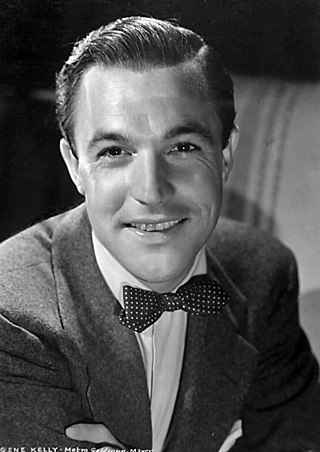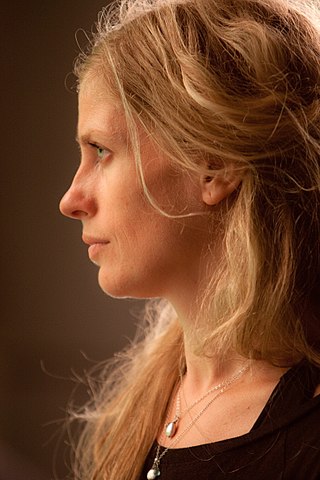Related Research Articles

Eugene Curran Kelly was an American dancer, actor, singer, director and choreographer. He was known for his energetic and athletic dancing style and sought to create a new form of American dance accessible to the general public, which he called "dance for the common man". He starred in, choreographed, and co-directed with Stanley Donen some of the most well-regarded musical films of the 1940s and 1950s.
Anik Bissonnette OC CQ is a Canadian ballet dancer. She started her professional ballet career with the Ballet de Montreal Eddy Toussaint in the 1980s. She was a principal dancer beginning in 1990 with Les Grands Ballets Canadiens. Her father, Jean Bissonnette, was a famous television director with Télévision de Radio-Canada.

Marie Chouinard OC is a Canadian dancer, choreographer, and dance company director.

Michael Greyeyes is an Indigenous Canadian actor, dancer, choreographer, director, and educator.
Moze Mossanen is a Canadian independent writer, director and producer who has created a body of critically acclaimed film and TV work blending drama, music, performance and documentary. Most recently, he wrote and directed the documentary feature, You Are Here: A Come From Away Story. His other works include Year of the Lion, a dance film adaptation of the novel, Dangerous Liaisons, and Nureyev, a docu-drama about the life of the Russian dancer Rudolf Nureyev.
Mitchell Rose is an American director of short films known for comedic work and dance film. He began his career as a choreographer and performance artist and became known at "the dance world's Woody Allen" after being so dubbed by The New York Times. He then migrated to film and his works have won numerous awards, notably Elevator World, Modern Daydreams, and Learn to Speak Body. He tours a program called The Mitch Show which features his films and audience participation pieces.

Crystal Pite is a Canadian choreographer and dancer. She began her professional dance career in 1988 at Ballet BC, and in 1996 she joined Ballett Frankfurt under the tutelage of William Forsythe. After leaving Ballett Frankfurt she became the resident choreographer of Montreal company Les Ballets Jazz de Montreal from 2001 to 2004. She then returned to Vancouver where she focused on choreographing while continuing to dance in her own pieces until 2010. In 2002 she formed her own company called Kidd Pivot, which produced her original works Uncollected Work (2003), Double Story (2004), Lost Action (2006), Dark Matters (2009), The You Show (2010), The Tempest Replica (2011), Betroffenheit (2015), and Revisor (2019) to date. Throughout her career she has been commissioned by many international dance companies to create new pieces, including The Second Person (2007) for Netherlands Dans Theater and Emergence (2009) for the National Ballet of Canada, the latter of which was awarded four Dora Mavor Moore Awards.

Paul-André Fortier is a Canadian choreographer and dancer living in Montreal. He is a recipient of the Governor General's Performing Arts Award for lifetime achievement.
Circle of the Sun is a 1960 short documentary film on Kainai Nation, or Blood Tribe, of Southern Alberta, which captured their Sun Dance ritual on film for the first time. Tribal leaders, who worried the traditional ceremony might be dying out, had permitted filming as a visual record.
José Navas is a contemporary choreographer and dancer born in Venezuela in 1965, and based in Montreal, Quebec.

Édouard Lock is a Canadian dance choreographer and the founder of the Canadian dance group, La La La Human Steps.
Lodela is a 1996 dance film directed by Philippe Baylaucq, and produced in Montreal by the National Film Board of Canada. The film received eight awards, including Best Short Documentary at the Hot Docs Canadian International Documentary Festival and a Special Jury Citation for Best Canadian Short Film at the Toronto International Film Festival, citing its "formal beauty and poetic cinematic construction". The film featured dancers José Navas and Chi Long, with Navas also serving as choreographer.

Nicolas "Nico" Archambault is a Canadian dancer and choreographer, who in 2008 won the first season of So You Think You Can Dance Canada. After the win, he became well known for his lead role in the 2011 Canadian film On the Beat .
John Melville Bishop is a contemporary, U.S., documentary filmmaker known for the breadth of his collaborations, primarily in the fields of anthropology and folklore. He has worked with Alan Lomax, John Marshall, and extensively with the Smithsonian Institution and the American Folklife Center at the Library of Congress. In 2005, he received a Lifetime Achievement Award from the Society for Visual Anthropology.

Miriam Elaine Adams is a dancer, choreographer, and dance archivist from Toronto. After performing with the National Ballet of Canada, she co-founded 15 Dance Laboratorium with her husband Lawrence Adams. It was the first theatre to present experimental dance in Toronto. In 1983, Miriam and Lawrence launched Encore! Encore! to document the works of six Canadian choreographers from the 1940s and 1950s, and in 1986 they launched a centre for archiving dance and publishing books called Arts Inter-Media Canada/Dance Collection Danse (DCD).

Gilles Jobin is a Swiss dancer, choreographer and director living and working in Geneva, Switzerland.

Clara Furey is a Canadian multidisciplinary artist: singer-songwriter, actress, dancer and choreographer.
Evann Siebens is a Canadian media artist with a background in dancing based in Vancouver, British Columbia, Canada. Her current practice cross-references dance performance and media. Siebens' film works have been shown both nationally and internationally and have won awards. She recently exhibited a geodesic dome and 360 projection at the Belkin Gallery in Vancouver and also screened a commissioned work on the exterior of the Vancouver Art Gallery. Her moving billboard Orange Magpies Triptych was part of Capture’s Photography Festival. She has also performed live with her media at New Media Gallery and the Western Front, Vancouver.

Kaveh Nabatian is an Iranian-Canadian musician and film director, known as a trumpeter and keyboardist with the Juno Award winning orchestral post-rock band Bell Orchestre.

Guillaume Côté is a Canadian ballet dancer, choreographer, composer and artistic director. He is currently a principal dancer and a Choreographic Associate at the National Ballet of Canada. He has been the Artistic Director of the Festival des Arts de Saint-Sauveur since 2014 and is the Artistic Director of Côté Danse.
References
- ↑ Odom, Selma; Bowring, Amy (2 February 2011). "Dance and the Media". The Canadian Encyclopedia . Archived from the original on 4 December 2022. Retrieved 13 February 2023.
- ↑ "The Evolving Story of Dance on Film: An overview of new forms then and now". Dance International Magazine. 18 May 2018. Retrieved 9 March 2019.
- ↑ Encyclopedia of Theatre Dance in Canada/ Encyclopédie de la danse théâtrale au Canada (2000). Arts Inter-Media Canada/Dance Collection Danse, Toronto, 672p.
- ↑ Judy Mitoma (2002). Envisioning Dance on Film and Video, Routledge, New York
- ↑ Aldor, Gaby (1997). "Labeling: The Dichotomy between Jewish and Israeli Dance". Jewish Folklore and Ethnology Review. 20: 150–157 – via books.google.ca.
- 1 2 Mitoma, Judy; ZIMMER, ELIZABETH; Stieber, Dale Ann (18 October 2013). Envisioning Dance on Film and Video. Routledge. ISBN 9781135376444.
- 1 2 "Laura Taler - Awards". IMDb . Archived from the original on 13 February 2023. Retrieved 12 February 2023.
- ↑ Segal, Lewis (19 April 2002). "An Intriguing Marriage of Choreography and Camera" . Los Angeles Times . Archived from the original on 13 February 2023. Retrieved 12 February 2023.
- ↑ "1998 Awards - Hot Docs". www.hotdocs.ca. Archived from the original on 21 August 2017.
- ↑ "Dance and the Media | The Canadian Encyclopedia". www.thecanadianencyclopedia.ca. Retrieved 9 March 2019.
- ↑ "Filmek - Love Songs". Media Wave Festival. Retrieved 12 February 2023.
- 1 2 Kelly, Deirdre (16 January 1991). "Independents a Hit in Informal Setting". Globe and Mail (Toronto).
- ↑ "ICI Berlin: Laura Taler". www.ici-berlin.org. Retrieved 4 December 2019.
- ↑ Mitoma, Judy; ZIMMER, ELIZABETH; Stieber, Dale Ann (18 October 2013). Envisioning Dance on Film and Video. Routledge. p. 305. ISBN 9781135376444.